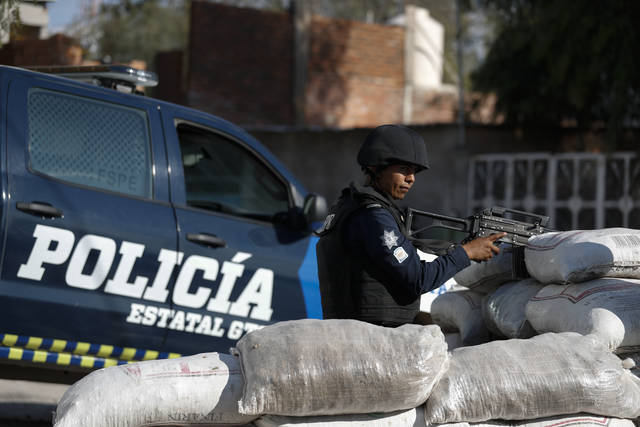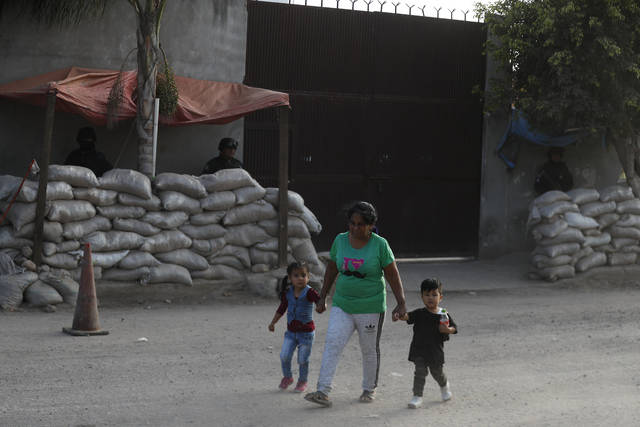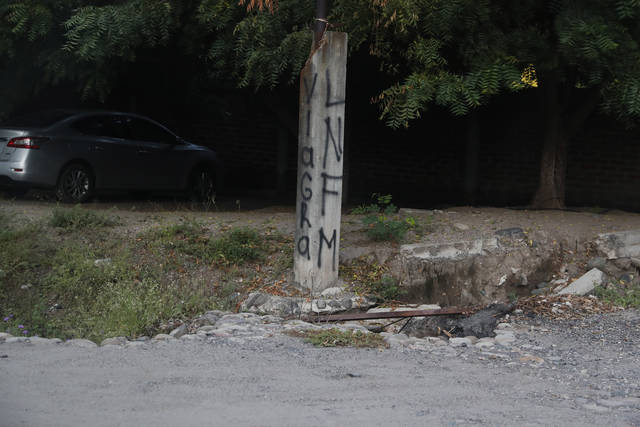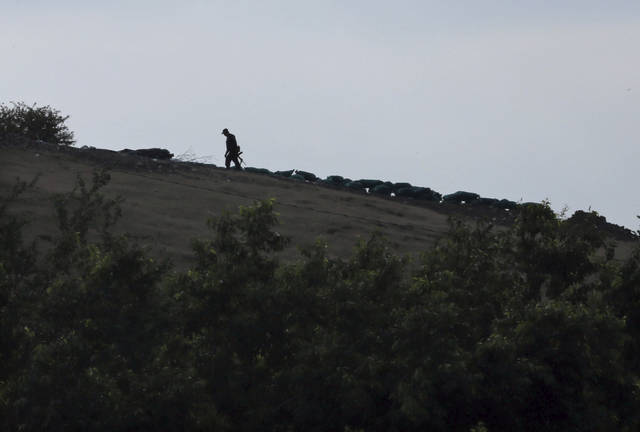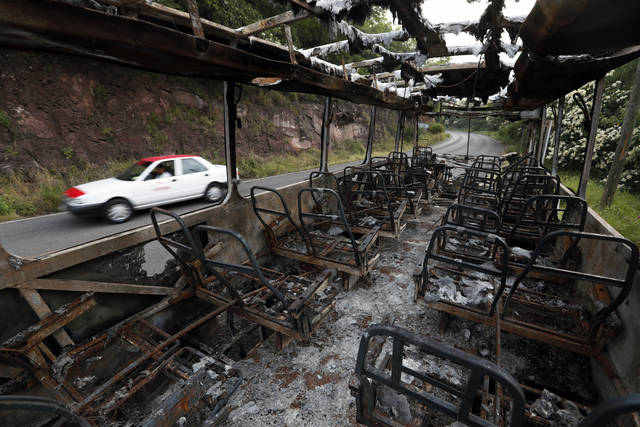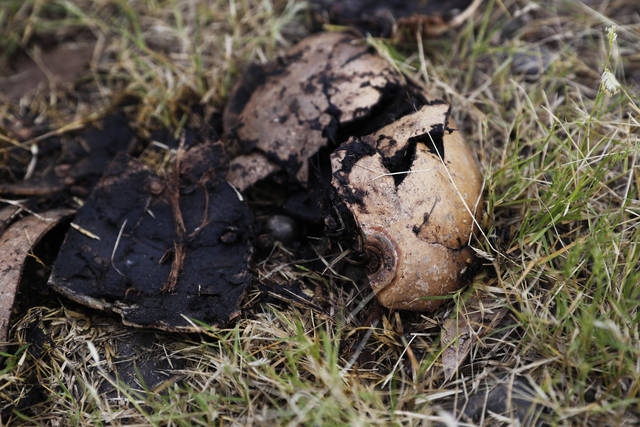In Mexico, a cartel is taking over: Jalisco New Generation
MEXICO CITY — Mexico’s fastest-rising cartel, the Jalisco New Generation gang, has a reputation for ruthlessness and violence unlike any since the fall of the old Zetas cartel. In parts of the country it is fighting medieval-style battles, complete with fortified redoubts, to expand nationwide, from the outskirts of Mexico City, into the tourist resorts around Cancun, and along the northern border.
Jalisco so likes violence and heavy armament that U.S. prosecutors said its operatives tried to buy belt-fed M-60 machine guns in the United States, and once brought down a Mexican military helicopter with a rocket-propelled grenade.
But Jalisco is also mounting a propaganda campaign, using videos and social media to threaten rivals while promising civilians that it won’t prey on them with extortion and kidnappings. It is a promise that cartels in Mexico have long made, and always broken. But Jalisco’s onslaught is so powerful that the cartel appears to have convinced some Mexicans, especially those who are tired of local gangs, to accept control by one large, powerful cartel.
“It seems like the Jalisco New Generation group is taking over everywhere,” said a priest in the western city of Apatzingan. “It seems like they allow people to work, and they don’t prey on civilians, they don’t kidnap, they don’t steal vehicles, they just go about their drug business.”
The priest, who is not being identified to prevent reprisals, would rather not have any gang in town. But one of his parishioners was recently kidnapped, raped and killed by members of a local gang, the Viagras, even after her family paid a ransom; locals are so sick of that gang they’d rather have anybody else move in.
He is not the only one. A restaurant owner in the central state of Guanajuato — where Jalisco is fighting for control with the local Santa Rosa de Lima gang — says he would prefer that Jalisco take over, because of the local gang’s chaotic ways.
“Things are quieter when Jalisco is around,” said the restaurant owner, who also asked his name not be used.
A woman who has lived for years under Jalisco cartel rule in a small town says she seeks out local Jalisco enforcers to solve common crime problems. “If you have a problem, you go to them. They solve it quickly,” she said.
It is all a lie, albeit one that the cartel likes to repeat.
“Beautiful people, continue your routine,” the cartel said in a banner hung from an overpass in 2019 to reassure residents of Apatzingan, Michoacán, that the cartel was moving in to kick out the Viagras. Beneath and around the banner a total of 19 corpses hung from ropes, lay piled on the roadway or were scattered, hacked to pieces.
Sofia Huett, the head security official in the central state of Guanajuato, has been on the receiving end of what she calls a propaganda war between Jalisco and the Santa Rosa gang.
“What is striking is the propaganda campaign in all media. What we are seeing today, we haven’t seen” since Mexico’s 2006-2012 drug war, she said, referring to decapitation videos, threats, and social media messages warning people to stay indoors.
“This propaganda doesn’t just seek to intimidate rivals, but the whole population, as well,” she said. “I would even say there may be political goals behind this type of messages.”
To those lured by the promises of the cartel, Huett said: “We cannot leave the public in doubt about the criminals, these false promises of protection and these false promises of well-being. This always ends badly.”
Indeed, the reality of life under the Jalisco cartel is terrifying: the cartel has made the city of Guadalajara and surrounding suburbs into a giant clandestine grave site.
Hundreds of bodies have been found in the last year, dumped in drainage canals, buried in fields and the patios and yards of homes. Bodies have been found dissolved in acid or lye, bodies have been found in plastic bags. So many bodies have been found in Guadalajara that authorities ran out of space at the morgue and took to moving rotting bodies around in refrigerated trucks until neighbors complained about the smell. Experts say the killings skyrocketed after the cartel lost control of its local organization in Guadalajara, and has been battling that splinter group.
Jalisco is accustomed to attacking law enforcement directly. The cartel is blamed for two of the worst attacks in recent memory: in October, cartel gunmen ambushed and killed 14 state police officers in Michoacán, and there are indications they executed some with gunshots to the head. In 2015, cartel gunmen trying to protect their leader shot down a Mexican military helicopter with an RPG.
Jalisco likes quasi-military tactics, and their hitmen favor military camouflage. In southern Guerrero state, they welded thick armor plating to a truck to make a homemade tank. In many states, they parade around in convoys of dozens of pickup trucks openly marked with the letters “CJNG.”
Jalisco really only understands force, a tactic that Mexico’s government has sidelined. On Friday, the foreign relations department wrote that the administration of President Andrés Manuel López Obrador “is committed to eliminating inequality and violence by ending the war on drugs … the use of force is no longer the first option.”
Indeed, López Obrador said his administration no longer seeks to detain drug lords.
Meanwhile, many of Jalisco’s front-line battlegrounds look almost medieval.
On the border between Jalisco and Michoacán states, there is a town called Tepalcatepec, a stronghold of the Viagras that Jalisco has recently tried to take over. The road in from Jalisco — the main route of attack — is blocked with piles of dirt and rocks staggered in a zigzag pattern, forcing incoming vehicles to slow down. From a house on a nearby hill, a vigilante with a .50-caliber sniper rifle scans the road, ready to fire.
Farther south in Michoacán, in the hamlet of El Terrero, Jalisco controls the south bank of the Rio Grande river, while the north bank remains in the hands of the rival New Michoacán Family cartel and its armed wing, the Viagras. The other gangs’ terror of Jalisco is evident; in September, they hijacked and burned a half-dozen trucks and buses to block the bridge over the river, to prevent Jalisco convoys from entering in a surprise assault.
Nearby, in the township of San Jose de Chila, rival gangs used a church as an armed redoubt to fight off an offensive by Jalisco gunmen. Holed up in the church tower and from its roof, they tried to defend the town against the incursion, leaving the church filled with bullet holes.
One thing is clear: Jalisco wants people to know that they’re in town. They hang banners from overpasses announcing their arrival, offering cash rewards for enemies and threatening police. They post videos on social media, usually with a few dozen heavily-armed, camouflage-clad men with helmets in the background, announcing they have come to “clean up the town.”
In Cancun, a man sidles up to a local crime-scene photographer at a taco stand. “We’re from Jalisco. We just want you to know that we’re here. Enjoy your meal,” the man said affably, before walking away.
It wasn’t just a boast. On Feb. 29, police in Cancun raided two houses and arrested 10 Jalisco gunmen with assault rifles and caps embroidered with the words “Grupo Delta, CJNG Quintana Roo.” The cartel is moving into Cancun the way it often does: the group “was setting up an operational center … where they abducted and killed members of rival gangs,” state prosecutors said.
The cartel has littered the streets of Cancun with the bodies of its victims, but the violence hasn’t really hit the tourist zone, except in the resort of Playa del Carmen, to the south.
While extreme violence is hardly new in Mexico, Jalisco is more fearsome than other cartels, more worrisome than even the notorious Zetas, who left piles of as many as 50 bodies on roads, kidnapped hundreds of people and forced them to fight each other to the death with sledgehammers, and burned their victims alive in gasoline drums.
The Zetas were never particularly good at carving out new drug routes or laundering money; Jalisco, with years of experience in methamphetamine production through their allies, the “Cuinis” gang, is in a prime position to capitalize on new synthetic drugs like fentanyl.
“CJNG’s efforts to dominate key ports on both the Pacific and Gulf Coasts have allowed it to consolidate important components of the global narcotics supply chain,” said a Congressional Research Service report. “In particular, CJNG asserts control over the ports of Veracruz, Manzanillo, and Lázaro Cardenas, which has given the group access to precursor chemicals that flow into Mexico from China and other parts of Latin America. As a result, CJNG has been able to pursue an aggressive growth strategy, underwritten by U.S. demand for Mexican methamphetamine, heroin, and fentanyl.”
And the cartel — like its main rival, Sinaloa — has been able to branch out into new regions of the world, turning to India when China cracks down on fentanyl shipments, and establishing connections with Chinese and other Asian gangs to launder drug proceeds that help wealthy Chinese get around their government’s currency flow limits and move their wealth abroad.
And under the steely command of Nemesio Oseguera, “El Mencho” — who is now the U.S. Drug Enforcement Administration’s most-wanted fugitive, with a $10 million price on his head — the Jalisco cartel has a more unified leadership than Sinaloa, whose command structure was fractured after the arrest, extradition and conviction of Joaquin “El Chapo” Guzman.
Now, experts say, much of the violence in Tijuana, Ciudad Juarez and Tamaulipas state is fueled by offensives by the Jalisco cartel, often in alliance with local gangs, to take control of key drug routes.
“They have an almost nationwide presence,”said Mexican security analyst Alejandro Hope. “It seems to me they have a more centralized decision-making structure than other criminal groups. The one who calls the shots is Mencho.”
Given that Jalisco has moved into hotels and restaurants, shopping centers, real estate companies, agricultural companies, and a music promotion business, Hope said “it appears they are more sophisticated than other (gangs) at laundering money.”
Remove the ads from your TribLIVE reading experience but still support the journalists who create the content with TribLIVE Ad-Free.

